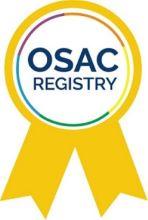June 2021
This Standards Bulletin from the Organization of Scientific Area Committees (OSAC) for Forensic Science provides a monthly update on:
- Standards moving through the OSAC Registry approval processes for published and OSAC Proposed Standards.
- Standards moving through the development process at standards developing organizations (SDOs).
Bulletin Summary:
- New standards added to the OSAC Registry: 3
- Standards under consideration for the Registry and open for comment: 9 (4 SDO published and 5 OSAC Proposed standards)
- New SDO published standards: 2
- Standards open for comment at SDOs: 7
In this issue
OSAC Registry Updates

The OSAC Registry is a repository of high-quality, technically sound published and proposed standards for forensic science. These written documents define minimum requirements, best practices, standard protocols and other guidance to help ensure that the results of forensic analyses are reliable and reproducible.
Three New Standards Added to the OSAC Registry
SDO Published Standards
- ASTM E2548-16 Standard Guide for Sampling Seized Drugs for Qualitative and Quantitative Analysis. Added June 1, 2021, this version will replace the 2011 version on the Registry.
OSAC Proposed Standards
- OSAC 2020-S-0002, Physical Stability of Facial Features of Adults (added June 1, 2021).
- OSAC 2020-S-0004, Standard for Interpreting, Comparing and Reporting DNA Test Results Associated with Failed Controls and Contamination Events (added June 1, 2021).
Standards Open for Comment
OSAC Registry Approval Process for Published Standards
The OSAC Registry approval process for published standards is used to review existing SDO published standards for technical quality and placement on the Registry. Please submit your comments by the deadline on whether the following SDO published standards should be included on the Registry.
Comment deadline June 4, 2021 by 11:59 p.m. ET:
- ANSI/ASB Technical Report 051, Scope of Work for a Footwear/Tire Examiner, First Edition, 2020. Submit your comments here.
- ASTM E3272-21 Standard Guide for the Collection of Soils and Other Geological Evidence for Criminal Forensic Applications. Submit your comments here.
- ADA Technical Report 1077-2020 Human Age Assessment by Dental Analysis. Submit your comments here.
Comment deadline July 1, 2021 by 11:59 p.m. ET:
- ANSI/ASB Standard 093, Standard Test Method for the Forensic Examination and Testing of Firearms, First Edition, 2020. Submit your comments here.
OSAC Registry Approval Process for OSAC Proposed Standards
The OSAC Registry approval process for OSAC Proposed Standards is used to review OSAC drafted standards for technical quality and placement on the Registry. The following OSAC draft proposed standards are being considered for submission to an SDO. The final draft provided to the SDO will be available on the OSAC Registry as an “OSAC Proposed Standard.” OSAC welcomes comments on whether the current draft is suitable for release to the SDO as well as suggestions for improvements in content and wording. To be considered, comments must be placed in the OSAC Comment Form and sent to comments [at] nist.gov (comments[at]nist[dot]gov) by the deadline.
Comment deadline June 4, 2021 by 11:59 p.m. ET:
- OSAC 2021-N-0020, Best Practice Recommendations for Limited Examinations.
- OSAC 2021-N-0025, Standard Guide for Printing Method Effects on Facial Comparisons.
Comment deadline July 1, 2021 by 11:59 p.m. ET:
- OSAC 2021-N-0007, Media Communications Following a Mass Fatality Incident: Best Practice Recommendations for the Medicolegal Authority.
- OSAC 2021-N-0008, Victim Accounting: Best Practice Recommendations for Medicolegal Authorities in Mass Fatality Management.
- OSAC 2021-S-0014, Standard for Reference Collections in Wildlife Forensic Biology: Genetics and Vertebrate Morphology.
Standards at FSSB for Vote
- ASTM E1968-19 Standard Practice for Microcrystal Testing in Forensic Analysis for Cocaine.
- ASTM E1969-19 Standard Practice for Microcrystal Testing in Forensic Analysis for Methamphetamine and Amphetamine.
- ASTM E2125-19 Standard Practice for Microcrystal Testing in Forensic Analysis for Phencyclidine and its Analogues.
Is your organization implementing standards on the OSAC Registry? Complete OSAC's Standards Implementation Declaration Form and send it to mark.stolorow [at] nist.gov (mark[dot]stolorow[at]nist[dot]gov) to let us know. Share your implementation experience and be featured in a future OSAC news post.
SDO Updates
The following standards have recently been published by the Academy Standards Board (ASB):
- ANSI/ASB Standard 130, Standard for Training in Forensic DNA Amplification Methods for Subsequent Capillary Electrophoresis Sequencing, First Edition, 2021. This standard, originally drafted by OSAC’s Human Forensic Biology Subcommittee and finalized by ASB’s DNA Consensus Body, provides the general requirements for a forensic DNA laboratory’s training program in forensic DNA amplification methods for subsequent capillary electrophoresis (CE) sequencing. This standard applies to forensic human and wildlife mitochondrial DNA amplification, and wildlife nuclear DNA amplification.
- ANSI/ASB Standard 134, Standard for Analyzing Pathological Conditions and Anomalies in Forensic Anthropology, First Edition, 2021. This standard, originally drafted by OSAC’s Forensic Anthropology Subcommittee and finalized by ASB’s Anthropology Consensus Body, sets forth techniques and approaches for describing, documenting, interpreting, and reporting pathological conditions and anomalies from skeletal and dental material and/or radiographic images. It does not provide guidance for distinguishing between anomalies and normal skeletal variation, nor does it address cause and manner of death classification or skeletal trauma.
Standards Open for Comment at SDOs
ASB:
- Recirculation* – ASB Standard 054, Standard for a Quality Control Program in Forensic Toxicology Laboratories, First Edition, 2021. This document establishes minimum requirements for quality control practices in forensic toxicology laboratories. The document explains the importance of a quality control program, how to select and care for materials used to prepare quality control samples, proper preparation and use of calibrator and control samples, and requirements for their use in different types of assays. The document also provides direction for the review and monitoring of quality control data in forensic toxicology laboratories. This standard applies to laboratories performing forensic toxicological analysis in the following sub-disciplines: postmortem forensic toxicology, human performance toxicology (e.g., drug-facilitated crimes and driving-under-the-influence of alcohol or drugs), non-regulated employment drug testing, court-ordered toxicology (e.g., probation and parole, drug courts, child services), and general forensic toxicology (non-lethal poisonings or intoxications). It is not intended for the area of breath alcohol toxicology. Comment deadline June 14, 2021.
- Recirculation* – ASB Best Practice Recommendation 060, Guidelines for Barrel and Overall Length Measurements for Firearms, First Edition, 2021. This document provides guidelines for measuring and reporting barrel length and overall length (BL-OL) of firearms, including guidelines for measurement traceability and estimating uncertainty of BL-OL measurements. This document does not apply to descriptive measurements of firearms. Comment deadline June 14, 2021.
- ASB Standard 157, Required Components for a Proficiency Testing Program in Bloodstain Pattern Analysis, First Edition, 2021. This standard establishes required components of a proficiency testing program in bloodstain pattern analysis. Components covered in this standard include the testing scheme, general test design, etc. It does not include specific test content. Comment deadline June 21, 2021.
- Recirculation* – ASB Standard 158, Standard for Developing Standard Operating Procedures in Bloodstain Pattern Analysis, First Edition, 2021. This standard provides guidance on the development of Standard Operating Procedures (SOP) that are a component of the quality assurance program for bloodstain pattern analysis. The standard specifies SOP requirements for equipment, materials, reagents, calculations, documenting limitations, safety and the generation of reports. The standard is applicable to scene, laboratory and remote examinations. Comment deadline June 21, 2021.
- ASB Standard 152, Standard for the Minimum Content Requirements of Forensic Toxicology Procedures, First Edition, 2021. This document provides requirements for the minimum content of analytical procedures in forensic toxicology. This standard applies to laboratories performing forensic toxicological analysis in the following sub-disciplines: postmortem forensic toxicology, human performance toxicology (e.g., drug-facilitated crimes and driving-under-the-influence of alcohol or drugs), non-regulated employment drug testing, court-ordered toxicology (e.g., probation and parole, drug courts, child services, breath alcohol), and general forensic toxicology (non-lethal poisonings or intoxications). Comment deadline July 5, 2021.
-
Recirculation* – ASB Standard 127, Standard for the Preservation and Examination of Charred Documents, First Edition, 2021. This document establishes the minimum required procedures used by Forensic Document Examiners (FDEs) in the preservation of, examination of, and reporting on charred documents. This generally includes the examination of charred documents for content (writing, printing), material (paper, cardboard, plastic, etc.) and source determination. This does not include chemical examination of documents for accelerants or source of combustion. Comment deadline July 12, 2021.
-
ASB Standard 128, Standard for the Preservation and Examination of Liquid Soaked Documents, First Edition, 2021. This document establishes the minimum required procedures used by Forensic Document Examiners (FDEs) in the preservation of, examination of, and reporting on liquid-soaked documents. This generally includes the examination of documents exposed to liquids (water, blood, oils, etc.) for content (writing, printing), material (paper, cardboard, plastic, etc.), and source determination. This standard does not include the examination of documents for the identification of the liquid contaminate(s). Comment deadline July 12, 2021.
For the ASB documents listed above, download the comment template and return it to asb [at] aafs.org (asb[at]aafs[dot]org) by the comment deadline.
Work Proposals for New or Revised Standards
The following documents are being initiated and are expected to result in new or revised standards.
ASB:
- On May 7, 2021, a Project Initiation Notification System (PINS) was published on page two in the ANSI Standards Action. This will begin a 30-day period for public comment on the initiation of ASB’s work on the following documents:
- BSR/ASB 169, Standard for Veterinary Forensic Live Animal Examination. This document provides minimum requirements for the forensic veterinary examination of a live animal and the collection of physical evidence. This includes the physical examination, ancillary testing, documentation, evidence handling, and training specific to the examination of live animals encountered in potential civil or criminal forensic cases involving animals.
- BSR/ASB 170, Standard for Veterinary Forensic Postmortem Examination. This standard defines services rendered by a veterinarian acting in a forensic capacity and performing veterinary forensic postmortem examinations. The standard establishes minimum practices and procedural requirements for receipt of the body, external and internal examinations, identification, documentation, and sets ancillary testing and diagnostic support requirements. The standard also provides a reference for legal or law enforcement professionals.
- On May 14, 2021, a PINS was published on page two in the ANSI Standards Action. This will begin a 30-day period for public comment on the initiation of ASB’s work on the following documents:
- BSR/ASB 165, Best Practice Recommendation for Analysis of Friction Ridge Impressions. This document provides the best practice recommendations for the analysis of friction ridge impressions as part of the Analysis, Comparison, and Evaluation examination methodology. These recommendations include how to assess, document the quality of friction ridge detail, categorize impressions based on their complexity, and document the utility of impressions for further examination. This document does not address the comparison or evaluation stages of the friction ridge examination methodology.
- BSR/ASB 166, Best Practice Recommendation for Comparison and Evaluation of Friction Ridge Impressions. This document provides the best practice recommendations for the comparison and evaluation of friction ridge impressions as part of the Analysis, Comparison, and Evaluation examination methodology. These recommendations include how to categorize comparisons between two friction ridge impressions on the basis of their complexity and specifies the criteria for supporting Source Conclusions. This document does not address the analysis stage of the friction ridge examination methodology.
- BSR/ASB 167, Standard for Reporting Results from Friction Ridge Examinations. This document prescribes the minimum administrative and technical information that are required to be included in friction ridge examination reports. This document does not include the requirements for supporting documentation of reported elements (e.g., case notes, custody documents, etc.) or testimony.
- BSR/ASB 168, Best Practice Recommendation for Testimony Monitoring in Friction Ridge Examination. This document provides the best practice recommendations for Forensic Service Providers (FSP) to review the appropriateness of testimony provided by its personnel related to friction ridge examination. Recommendations include how to review testimony and assess whether methods, limitations, and interpretations of work performed were conveyed in accordance with established best practices. This document does not address the Technical Review of case files or results of friction ridge examinations.
- On May 28, 2021, a PINS was published on page two in the ANSI Standards Action. This will begin a 30-day period for public comment on the initiation of ASB’s work on the following documents:
- BSR/ASB 161, Best Practice Recommendation for Creating Known Distance Witness Panels and Estimating the Associated Measurement Uncertainty. This best practice recommendation provides guidelines for the creation of known-distance witness panels for use in muzzle-to-target distance determination testing. This includes guidelines for measurement traceability and estimating the uncertainty of measurement of distance regarding the creation of witness panels.
- BSR/ASB 162, Standard for the Forensic Examination and Documentation of Non-Firearm Tools and Toolmarks. This document provides procedures for the examination, documentation, and reporting of non-firearm tools and toolmarks by forensic toolmark examiners. This document does not cover the microscopic comparison of toolmarks.
- BSR/ASB 164, Standard Test Method for Muzzle to Target Distance Determinations. This standard provides procedures for the visual, microscopic, and chemical processing of items for the determination of muzzle-to-target distance, including the comparison of known-distance witness panels to the questioned item. This standard contains procedures for the analysis of both gunshot residue patterns and the impact pattern from multiple projectile ammunition (e.g., shotshells). This standard does not cover creation of witness panels or procedures for estimating associated measurement uncertainty of distance.
- BSR/ASB 171, Best Practice Recommendations for the Management and Use of Quality Assurance DNA Elimination Databases to Detect and Monitor Contamination in Forensic DNA Analysis. This document provides best practice recommendations for collecting, storing, searching, and retaining DNA profiles for quality assurance purposes. This document addresses the use of quality assurance databases as a method to detect and monitor contamination.
Other News

Coming Soon: OSAC Registry Implementation Survey
OSAC is seeking to understand how organizations are using standards on the OSAC Registry and what support they need to improve implementation. To do that, we will be releasing the first of an annual survey that will assess the current state of Registry implementation. The survey is intended to be a yearly snapshot and assessment, and the first one will cover the Registry standards posted through March 2021.
The survey is expected to open June 10 and will close August 20. Results of the survey will be shared in OSAC’s Fall Newsletter/Annual Report, later in October. If you have any questions, please email the OSAC Program Office at forensics [at] nist.gov (forensics[at]nist[dot]gov).
Other Forensic Science News, Events & Training
Reminder: NIJ Proposals for Research and Development in Forensic Science for Criminal Justice Purposes Due June 3
The National Institute of Justice (NIJ) is seeking proposals for rigorous basic or applied research and development projects in forensic science. Need ideas for projects? Check out the research and development needs identified by OSAC’s subcommittees.
Learn more and apply by June 3, 2021.
CSAFE Updates
Our colleagues at the Center for Statistics and Applications in Forensic Evidence (CSAFE) will be hosting their 2021 Field Update on June 14 from 11:00 – 4:00 p.m. CDT. During this event, CSAFE researchers will highlight the Center’s current research projects and give you information and tools you can use. The Field Update will also provide you a chance to give feedback, suggestions or ask questions. This event is free, open to the public, and registration is required. See the agenda and register here.
ASB Updates
AAFS and ASB will be hosting a webinar, Standard Practices for Measurement Traceability in Forensic Toxicology, on June 17 from 1:00 p.m. – 2:00 ET. This webinar, featuring several OSAC members, will provide:
- An introduction of ASB and the SDO process.
- Information on why metrological traceability is important.
- A walkthrough of ANSI/ASB Standard 017, Standard Practices for Measurement Traceability in Forensic Toxicology.
- Details on how ASB 017 applies to specific clauses of ISO/IEC 17025 and ANAB AR 3125.
- A live Q&A session
There is a $25 registration fee to attend. Click here for more information and to register.
FTCoE Updates
NIJ’s Forensic Technology Center of Excellence (FTCoE), provides evidence-based resources about forensic technologies and emerging challenges. Check out their upcoming activities, including several ASCLD Train the Directors Series webinars on successful onboarding in crime labs and firearms 3D technology. Also listen to past episodes of the Just Science podcasts from their Sexual Assault Awareness Month mini season.
Visit the FTCoE website for other resources and forensic science events.

Get Involved with OSAC
OSAC offers a variety of ways for members, affiliates, and other experts in the forensic science community to participate in the standards advancement process. Click here to learn how you can help make an impact on the forensic science community through standards.

